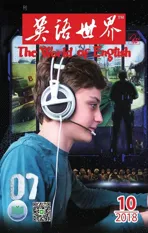Plastic-eating Bugs? It’s a Great Story—But There’s a Sting in the Tail
2018-11-28By
By
Caterpillars1caterpillar毛虫。that can munch up2munch up食用。plastic bags have just been identified, fueling excited speculation3speculation猜测,推测。that this could one day eliminate global pollution from plastic waste.The chance discovery, initially made by a scientist and amateur beekeeper whose plastic bag had been eaten through by the moth caterpillars, was reported by researchers at Cambridge University and the Spanish National Research Council4西班牙高等科学研究理事会,是西班牙最大的多学科科研组织。.
日前,人们发现了能吃掉塑料袋的毛虫。这激起了人们的无限遐想:或许有朝一日,全球塑料垃圾污染问题会因此而得以解决。这一偶然发现首先要归功于一位科学家,他是个养蜂爱好者,发现蛾蛹咬破了他的塑料袋。剑桥大学和西班牙高等科学研究理事会的研究员报道了该发现。
[2]How thoughtful5thoughtful体贴的,关心的。of nature to provide bugs that eat our rubbish.Is this the end oflandfill, turtles with plasticcongested stomachs, and trees adorned with tattered ribbons of shopping bags?
[2]大自然如此体贴,竟然创造出虫子来消化我们制造的垃圾!这是不是意味着垃圾场将不复存在?海龟将不再饱受胃里塞满塑料的折磨?树枝挂满破烂购物袋的场景将一去不复返?
[3]Well, it’s never that simple, is it?Attempts to commandeer6commandeer征用,霸占。nature to do our dirty work never seem to turn out as hoped, whether these take the form of planting trees to soak up7soak up吸收。carbon dioxide, or introducing invasive species for pest control, or using microorganisms to clean up oil spills.Remember the Australian cane toad8toad蟾蜍。debacle9debacle(由于计划无法实现而导致的)惨败;崩溃。? The toads were introduced in the 1930s to control crop pests but instead gorged themselves on other local wildlife and spread across the country.
[3]答案绝非如此简单。不管是通过植树吸收二氧化碳,还是通过引入外来物种防治病虫害,抑或是利用微生物清理溢油,强迫自然为我们效力,替我们干脏活儿,结果似乎都不尽如人意。还记得澳大利亚当年向甘蔗地里投放蟾蜍的前车之鉴吗?20世纪30年代,为了控制作物害虫,澳大利亚引入了蟾蜍,但结果发现,这些蟾蜍没吃害虫,反而大量吞食当地其他野生生物,并大肆繁衍,祸及整个澳大利亚。
[4]These creatures, the larvae10larva(昆虫的)幼虫,幼体。of the greater wax moth (Galleria mellonella),can devour polyethylene11polyethylene聚乙烯。, which along with the closely related polypropylene12polypropylene聚丙烯。is the main type of plastic found in waste.But you’d need an awful lot of them to make a significant dent13dent减少,耗减。on the plastic waste problem.The UK alone discards almost 2m tons of this stuff every year.At the rate of consumption reported by the researchers—one worm gets through about two milligrams of plastic a day—you’d need billions of caterpillars eating constantly all year round to deal with that.
[4]虽然大蜡螟(也称大蜡蛾)的幼虫能够迅速吃掉聚乙烯(和聚丙烯关系紧密,二者同是塑料垃圾的主要类型),但是若想行之有效地解决塑料垃圾问题,需要的蜡螟不可胜数。仅在英国,每年就丢弃200万吨塑料垃圾。按照研究人员报道的消耗速度——每条虫子每天大概消耗2毫克塑料,那么处理掉这200万吨塑料垃圾,需要数十亿只毛虫夜以继日地吃上一整年。
[5]Quite aside from how and where you’d farm all these bugs, there’s something about them that news reports have failed to mention.Wax moths, which are found throughout the world, are so-called because they eat wax.Spe-cifically, they love to eat the wax from which bees make their honeycombs—and so they can devastate bee colonies14colony群体,群落。.The two common species of wax moth, of which Galleria mellonella is one, are thought to cause more than £4m worth of damage annually in the United States alone.
[5]如何养殖这些虫子?在哪里养殖?抛开这些不谈,有一些关于虫子的问题新闻报道没有提及。蜡螟遍布世界各地,因喜吃蜂蜡而得名。更确切地说,它们喜欢吃蜜蜂建造蜂巢所用的蜂蜡——因此,它们可能摧毁整个蜂群。有两种常见蜡螟每年仅在美国就会造成400多万英镑的损失,大蜡螟是其中之一。
[6]With bee populations already under severe stress from pesticides,habitat loss and predators, we might want to think twice about breeding one of their common airborne155 airborne空气的;飞行中的。enemies in huge numbers—even if the intention was to somehow keep them in plasticsprocessing centres.The idea that if bees disappear then humankind will follow four years later, popularly misattributed to Albert Einstein16自1994年起,社会上便流传“如果蜜蜂从地球上消失,人类将只能再存活4年。没有蜜蜂,没有授粉,没有植物,没有动物,也就没有人类。”是爱因斯坦说的,但其实没有任何证据表明爱因斯坦曾经说过或写下过这样的言论。人们很早就发现一种蜜蜂神秘死亡的现象,称为“蜂群崩溃混乱症”(Colony Collapse Disorder)。在媒体开始关注蜂群崩溃混乱症之后,爱因斯坦的这段话才开始风传。, might be a touch17touch有点儿。hyperbolic.But without their pollinating18pollinate对……授粉。assistance, crop cultivation would be in deep trouble.
[6]由于受到杀虫剂毒害、栖息地面积消减以及捕食者捕食的影响,如今蜜蜂的数量已不容乐观。因此,大规模培养蜜蜂“会飞的”敌人——即使这样做的初衷是控制蜡螟在塑料处理中心发挥作用,我们也要三思而后行。有一种说法是,如果蜜蜂灭绝了,那么人类在4年后也会随之消失——人们普遍误以为这是爱因斯坦说的。这种观点听起来可能有点儿夸张,但是如果没有蜜蜂帮助授粉,庄稼种植会陷入困境。
[7]Polyethylene sits around in the environment because its molecules are so hard to break down.Ordinary soil microorganisms don’t have the resources for it.These plastics are built up from the hydrocarbon molecules in oil, and ideally we’d turn them back into oil after we had used them, regenerating a valuable substance rather than sacrificing it as waste.Chemists have been working long and hard to do that, using special catalysts to induce the chemical reactions.But it’s tough, and only very recently have they started to see progress.It’s precisely because wax is chemically similar to polyethylene that the wax moth caterpillars can biodegrade19biodegrade进行生物降解。it.
[7]聚乙烯分子很难降解,所以这种物质能够长期存在于自然环境中。普通的土壤微生物对其束手无策。这种塑料由石油中的碳氢化合物分子合成而来,理想情况下,我们可以在使用完塑料后将其重新转化成石油,使其摆脱沦为废品的命运,重新成为一种有用的物质。化学家们一直为此而努力,他们致力于使用特殊的催化剂来诱导化学反应。但是这项研究困难重重,直到最近才开始有点儿进展。正是由于蜂蜡的化学性质与聚乙烯相似,所以蜡螟幼虫可以将其生物降解。
[8]A far easier and less hazardous solution to the plastic problem could be found in bacteria, however.After all, it seems you can find bacteria that will eat almost anything.Some happily devour toxic chemicals, such as perchlorate(weed killer); others thrive amid radioactive waste.And indeed last year a team of Japanese scientists identified a bacterium existing in the wild that can feed on another common plastic, polyethylene terephthalate20polyethylene terephthalate聚酯合成纤维,聚乙烯对苯二甲酸酯。, which is used to make bottles for soft drinks and water.
[8]然而,就解决塑料问题而言,细菌比蜡螟更简单,并且危害更小。毕竟,细菌似乎什么东西都能吃。有些细菌能够肆无忌惮地吞食有毒化学物质,如高氯酸盐(一种除草剂);有些细菌则能在放射性垃圾中茁壮成长。其实,日本的一个科学家小组去年就发现了一种生存在野生环境中的细菌,这种细菌能够以聚酯合成纤维为食。聚酯合成纤维是另外一种常见塑料,用来制作饮料瓶和水瓶。
[9]It’s possible that bacteria might,in fact, be responsible for the plasticdigesting ability of Galleria mellonella larvae.Another wax-eater, the Indian mealmoth, was found in 2014 to house bacteria in its digestive tract that can break down polyethylene.Galle-ria might prove to have such gut21gut内脏;肠子。bacteria too.
[9]实际上,蜡螟幼虫之所以具备塑料消化能力,可能要归功于这种细菌。除蜡螟之外,印度谷螟虫也食用蜂蜡。2014年就有研究发现,印度谷螟虫的消化道内存在能降解聚乙烯的细菌。很可能蜡螟体内也有这种肠道细菌。
[10]Those bacteria could provide the ideal solution.They could be brewed up22brew up酿造。in fermentation vats that would dissolve plastics without anyone having to contemplate breeding vast wax moth colonies.Alternatively, it might be possible to extract the particular enzymes23enzyme酶。the caterpillars use and put them to work on their own—a kind of concentrate of gastric juices24gastric juice胃液。.
[10]这些细菌可以提供理想的解决方案。我们可以在发酵桶中培养它们,不必担心大量繁殖蜡螟的问题,它们就将塑料消化了。或者,我们也可以从毛虫体内提取特定的几种酶——类似于浓缩的胃液——并让它们各自发挥作用。
[11]These are the real reasons why the new discovery is promising, and not because we’ll soon be feeding plastic bags to caterpillars.As usual with science, you don’t get the solution on a plate25on a plate现成地;不费力地。, but have to follow clues with patience and care.It doesn’t make for great headlines.But honestly, the bees would thank you for it.
[11]以上就是这项新发现充满希望的真正原因。这并不是说我们马上就可以将塑料袋投食给毛虫。科研工作通常需要耐心细致地追查线索,不可能不费吹灰之力就得到解决方案。虽然这项新发现不会成为头条新闻,但实事求是地说,蜜蜂会为此而对人类抱有感激之情。
ESports’ Freaks Vocabulary
Nerf:The opposite of a buff, but instead with developers making something weaker.
Rekt:Abbreviation of wrecked.Used when someone losing very badly.
Strat:Short for strategy.
